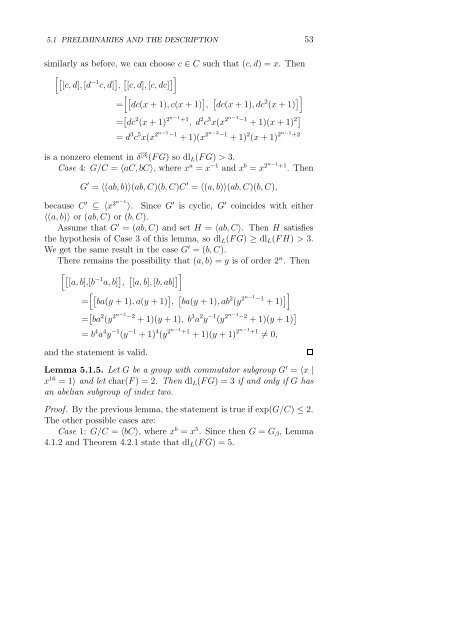On the Derived Length of Lie Solvable Group Algebras
On the Derived Length of Lie Solvable Group Algebras
On the Derived Length of Lie Solvable Group Algebras
You also want an ePaper? Increase the reach of your titles
YUMPU automatically turns print PDFs into web optimized ePapers that Google loves.
5.1 PRELIMINARIES AND THE DESCRIPTION 53<br />
similarly as before, we can choose c ∈ C such that (c, d) = x. Then<br />
[c, d], [d −1 c, d] , [c, d], [c, dc] <br />
dc(x <br />
2<br />
= + 1), c(x + 1) , dc(x + 1), dc (x + 1) <br />
= dc 2 (x + 1) 2n−1 +1 2 3 2<br />
, d c x(x n−1−1 2<br />
+ 1)(x + 1) <br />
= d 3 c 5 x(x 2n−1 −1 + 1)(x 2 n−2 −1 + 1) 2 (x + 1) 2 n−1 +2<br />
is a nonzero element in δ [3] (F G) so dlL(F G) > 3.<br />
Case 4: G/C = 〈aC, bC〉, where x a = x −1 and x b = x 2n−1 +1 . Then<br />
G ′ = 〈(ab, b)〉(ab, C)(b, C)C ′ = 〈(a, b)〉(ab, C)(b, C),<br />
because C ′ ⊆ 〈x2n−1〉. Since G ′ is cyclic, G ′ coincides with ei<strong>the</strong>r<br />
〈(a, b)〉 or (ab, C) or (b, C).<br />
Assume that G ′ = (ab, C) and set H = 〈ab, C〉. Then H satisfies<br />
<strong>the</strong> hypo<strong>the</strong>sis <strong>of</strong> Case 3 <strong>of</strong> this lemma, so dlL(F G) ≥ dlL(F H) > 3.<br />
We get <strong>the</strong> same result in <strong>the</strong> case G ′ = (b, C).<br />
There remains <strong>the</strong> possibility that (a, b) = y is <strong>of</strong> order 2n . Then<br />
[a, <br />
−1<br />
b],[b a, b] , [a, b], [b, ab] <br />
ba(y 2 2<br />
= + 1), a(y + 1) , ba(y + 1), ab (y n−1 −1<br />
+ 1) <br />
= ba 2 (y 2n−1−2 3 2 −1 2<br />
+ 1)(y + 1), b a y (y n−1 <br />
−2<br />
+ 1)(y + 1)<br />
= b 4 a 4 y −1 (y −1 + 1) 4 (y 2n−1 +1 + 1)(y + 1) 2 n−1 +1 = 0,<br />
and <strong>the</strong> statement is valid.<br />
Lemma 5.1.5. Let G be a group with commutator subgroup G ′ = 〈x |<br />
x 16 = 1〉 and let char(F ) = 2. Then dlL(F G) = 3 if and only if G has<br />
an abelian subgroup <strong>of</strong> index two.<br />
Pro<strong>of</strong>. By <strong>the</strong> previous lemma, <strong>the</strong> statement is true if exp(G/C) ≤ 2.<br />
The o<strong>the</strong>r possible cases are:<br />
Case 1: G/C = 〈bC〉, where x b = x 5 . Since <strong>the</strong>n G = Gβ, Lemma<br />
4.1.2 and Theorem 4.2.1 state that dlL(F G) = 5.


